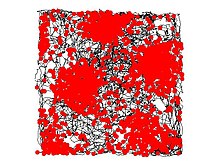grid cell
mrežna celica
A grid cell is a type of neuron within the entorhinal cortex that fires at regular intervals as an animal navigates an open area, allowing it to understand its position in space by storing and integrating information about location, distance, and direction. Grid cells have been found in many animals, including rats,mice,bats,monkeys, and humans.
Grid cells were discovered in 2005 by Edvard Moser, May-Britt Moser, and their students Torkel Hafting, Marianne Fyhn, and Sturla Molden at the Centre for the Biology of Memory (CBM) in Norway. They were awarded the 2014 Nobel Prize in Physiology or Medicine together with John O'Keefe for their discoveries of cells that constitute a positioning system in the brain. The arrangement of spatial firing fields, all at equal distances from their neighbors, led to a hypothesis that these cells encode a neural representation of Euclidean space. The discovery also suggested a mechanism for dynamic computation of self-position based on continuously updated information about position and direction.
To detect grid cell activity in a typical rat experiment, an electrode which can record single-neuron activity is implanted in the dorsomedial entorhinal cortex and collects recordings as the rat moves around freely in an open arena. The resulting data can be visualized by marking the rat's position on a map of the arena every time that neuron fires an action potential. These marks accumulate over time to form a set of small clusters, which in turn form the vertices of a grid of equilateral triangles. The regular triangle pattern distinguishes grid cells from other types of cells that show spatial firing. By contrast, if a place cell from the rat hippocampus is examined in the same way, then the marks will frequently only form one cluster (one "place field") in a given environment, and even when multiple clusters are seen, there is no perceptible regularity in their arrangement.




